Faroe Islands
Template:Infobox State/Maintenance/NAME-German
The Faroe Islands [ˈfɛːʁøɐ], colloquially often Faroe Islands (Faroese Føroyar [ˈfœɹjaɹ], Danish Færøerne [ˈfɛɐ̯ˌøːˀɐnə] "the Sheep Islands"), are a group of 18 islands with autonomous administration belonging to Denmark. They lie in the North Atlantic between Scotland, Norway and Iceland. They were discovered and settled in the Middle Ages. Today, all but the smallest island, Lítla Dímun, are permanently inhabited.
The majority of the island's 50,000 inhabitants - the Faroese, also known as the Faroese - do not consider themselves to be Danish, but rather an independent people descended from the Vikings on the Faroe Islands. They speak the Faroese language, which originated from Old West Norse and is related to Icelandic and Norwegian.
According to the 2005 Treaty of Fámjin, the Faroese, like the Greenlanders, form an "equal nation" within the Kingdom of Denmark. Their islands have enjoyed extensive autonomy since 1948 and have one of the oldest parliaments in the world, the Løgting. It regularly sends two deputies to the Danish Folketing and is represented by two delegates in the Nordic Council.
Unlike the core country Denmark, the Faroe Islands are not part of the European Union and do not belong to the customs territory of the Union pursuant to Article 4(1) of the European Customs Code. Therefore, all treaties concerning the EU or its functioning do not apply to the Faroe Islands. They belong to the Pan-Euro-Mediterranean zone for the harmonisation of rules of origin of goods. Since 1 November 2006, the Faroe Islands have formed an economic union with Iceland. Iceland, Greenland and the Faroe Islands have been cooperating in the Western Nordic Council since 1985.
Until the 19th century, sheep farming was the most important occupation and Faroese wool the most important export. Today, the Faroe Islands are dominated by fishing and the associated economy. Since the mid-1990s, oil has been sought in the waters around the islands; however, all previous test drillings have been unsuccessful.
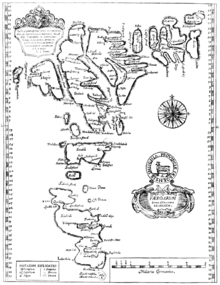
FÆROARUM - Prima & accurata delineatio. The oldest known Faroese map was drawn by Lucas Debes in 1673.
Population
Ethnic composition
Of the approximately 50,000 inhabitants of the Faroe Islands (spread over more than 17,000 private households), 98 % are Reich citizens, i.e. Faroese, Danes or Greenlanders. From the place of birth one can deduce the following origin of the inhabitants: 91.7% were born in the Faroe Islands, 5.8% in Denmark and 0.3% in Greenland. Together with some naturalised people, these three groups make up the Reich citizens.
The largest group of foreigners are Icelanders with 0.5%, followed by Norwegians with 0.37%, Filipinos with 0.27%, Thais with 0.23% and British with 0.2%. In total, people from 77 countries live in the Faroe Islands.
It is not possible to draw conclusions about the Faroese native speakers from these figures for two reasons: Firstly, a great many Faroese native speakers live in Denmark, quite a few were born there and return with their parents or as adults in the course of their lives. Secondly, there are long-established Danish families in the Faroe Islands who speak Danish at home.
Demographic development
If the first inhabitants of the Faroe Islands, Irish monks, lived as small groups of hermits, a significant population arose through the land-grabbing of the Vikings, which leveled off at about 4000 inhabitants and never exceeded 5000 until the 18th century. Around 1349/50, about half the population died of the plague. A further wave of immigration from Scandinavia gradually compensated for this population loss. Only with the advent of deep-sea fishing (and thus independence from difficult agriculture) and the general progress in health care, a rapid population growth took place in the Faroe Islands. From the end of the 18th century the population increased tenfold within 200 years. In the early 1990s, there was a severe economic crisis with noticeable emigration, but this reversed to net immigration in subsequent years. By the time the 48,000 population mark was passed in 2004, the population had returned to roughly the same level as at the beginning of the crisis in the early 1990s. In April 2015, the population reached a new high of 48,795, and in August 2015, for the first time in Faroese history, more than 49,000 people lived on the 18 rocky islands in the North Atlantic.
The Faroe Islands are one of the countries in the world where there are more male than female inhabitants. There are 52% male inhabitants and 48% female inhabitants (1 January 2007). In the 20-39 age group, the difference is 11%. This is mainly due to the employment situation for young women.
Faroese women have an average of 2.6 children. That is the highest birth rate of the Nordic countries. At the same time, it has the fewest divorces, the fewest suicides and the fewest abortions. Population growth in 2015 was +0.8%.
Life expectancy in 2016 was 80.4 years overall (men: 77.8 years/ women: 83.1 years).
| Year | Inhabitants |
| 1327 | approx. 4,000 |
| 1350 | approx. 2,000 |
| 1769 | 4.773 |
| 1801 | 5.255 |
| 1834 | 6.928 |
| 1840 | 7.314 |
| 1845 | 7.782 |
| 1850 | 8.137 |
| 1855 | 8.651 |
| 1880 | 11.220 |
| 1900 | 15.230 |
| 1911 | approx. 18,800 |
| 1925 | 22.835 |
| 1950 | 31.781 |
| 1970 | approx. 38,000 |
| 1975 | 40.441 |
| Year | Inhabitants |
| January 1, 1985 | 45.318 |
| January 1, 1990 | 47.770 |
| 1 January 1995 | 43.644 |
| 1 January 1997 | 43.751 |
| 1 January 1998 | 44.235 |
| 1 January 1999 | 44.772 |
| 1 January 2000 | 45.353 |
| 1 January 2001 | 46.144 |
| 1 January 2002 | 46.961 |
| 1 January 2003 | 47.668 |
| 1 January 2004 | 48.178 |
| 1 January 2005 | 48.337 |
| 1 January 2006 | 48.170 |
| January 1, 2007 | 48.327 |
| January 1, 2008 | 48.360 |
| January 1, 2009 | 48.716 |
| Year | Inhabitants |
| January 1, 2010 | 48.660 |
| 1 January 2011 | 48.583 |
| 1 January 2012 | 48.287 |
| 1 January 2013 | 48.204 |
| 1 January 2014 | 48.308 |
| 1 January 2015 | 48.704 |
| 1 January 2016 | 49.192 |
| 1 January 2017 | 49.884 |
| January 1, 2018 | 50.498 |
| January 1, 2019 | 51.371 |
Language
Originating from Old Norse, Faroese is one of the smallest Germanic languages. It is most intelligible to speakers of Icelandic and West Norwegian dialects. Its closest relative was the now extinct Norn of the Shetland Islands.
With the Reformation, it was replaced by Danish in all official areas around 1540, and for centuries it was only passed on orally in the form of the countless Faroese ballads. Pioneers such as Jens Christian Svabo and Johan Henrik Schrøter ensured that their language was first written down at the end of the 18th, beginning of the 19th century. V. U. Hammershaimb and Jakob Jakobsen formed the present orthography. As a result of the language dispute in the 20th century, Faroese was able to assert itself as the main language in all areas, so that Danish today only has the character of an official lingua franca. For example, Faroese laws must always be translated into Danish.
Signs and announcements are basically in Faroese, and if a second language is added, it is English, not the official second language Danish, which is taught in school and therefore understood - at least in writing - by most Faroese. Other foreign languages are German and French.
The Faroese language policy, coined by Jóhan Hendrik Winther Poulsen, ensures an active re-creation of terms used in modern life. It is similarly purist to that in Iceland and avoids foreign words and Anglicisms.
In addition to the approximately 45,000 ethnic Faroese on the Faroe Islands themselves, there are at least 15,000 other native speakers, mostly in Denmark. In 1998, Føroysk orðabók, the first native dictionary, was published. Faroese can be studied at the University of the Faroes.
For patronymic and metronymic naming rights, which have been in effect again since 1992, see Faroese personal names.
Religion
See also: Faroese Folk Church, Faroese Wooden Churches and List of Church Buildings in the Faroes
The Faroe Islands were Christianized from 999 by Sigmundur Brestisson. Already before that Irish monks lived there as hermits. Almost all Faroese are Christians. In 2017, about 80% of the inhabitants were members of the Evangelical Lutheran state church. About 7-10% are members of the Brethren congregations (in Faroese: Brøðrasamkoman), which were founded through the work of the revivalist preacher William Gibson Sloan.
About 5 % belong to other Christian churches: Apart from the Pentecostals with their seven churches, there are the Adventists, who run a relatively large general education private school in Tórshavn, and the approximately 124 Jehovah's Witnesses in four congregations. The Catholic Church in the Faroes today has about 270 members. Its old Franciscan school is now run again by the municipality of Tórshavn.
In addition, there are about 15 Bahai who meet in four different places. Ahmadiyya Muslims founded their own community in 2010.
The most famous church buildings include Olav's Church and the unfinished Magnus Cathedral in Kirkjubøur, Tórshavn Cathedral, St. Mary's Catholic Church in Tórshavn, Christianskirkjan in Klaksvík, Fámjin Church, the octagonal church in Haldórsvík and, last but not least, Gøtu Kirkja in Norðragøta.
Bible translations in Faroese appeared in 1948 (Victor Danielsen, Church of the Brethren) and 1961 (Jacob Dahl and Kristian Osvald Viderø, State Church).
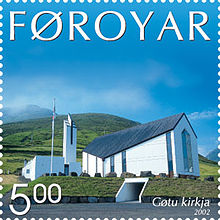
The new church in Gøta was consecrated by Queen Margrethe.
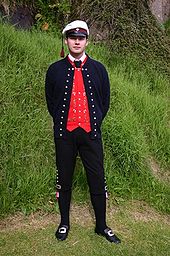
Faroese are increasingly wearing their traditional costumes again; nowadays almost every high school graduate wears them at the graduation ceremony (here with the typical student cap).

The village of Kvívík around 1900
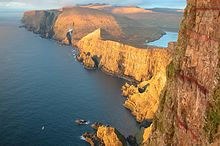
While the western coasts of the islands are often steep and inaccessible, the land slopes flatly towards the east; it is there in the bays that most Faroese live. View from the cliff Beinisvørð to the north.
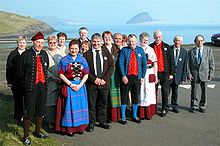
Faroese in Faroese costume
Politics and government institutions
Management structure
Regions
| Region | Inhabitants (2012) |
| Norðoyar | 5.829 |
| Eysturoy | 10.726 |
| Streymoy | 22.711 |
| Vágar | 3.078 |
| Sandoy | 1.327 |
| Suðuroy | 4.680 |
Generally, a distinction is made between six geographical regions. These are identical to the sýslur (syssel), which originally formed legal and police districts, each headed by a sýslumaður (sysselman). Today, the Tórshavn Police Directorate has five police sections under it.
- Norðoya sýsla: The most rugged landscapes and most of the highest mountains are found on the six northern islands in the northeast. These are: Kalsoy, Kunoy, Borðoy, Viðoy, Svínoy and Fugloy in the very east of the Faroe Islands. The North Islands metropolis Klaksvík on Borðoy is the second largest town and the most important location of the fishing industry. Viðareiði on Viðoy is the northernmost town in the country in the middle of a unique landscape.
- Eysturoyar sýsla: Eysturoy, the second largest island of the archipelago, is located west of the northern islands. Together with Streymoy it forms the centre of the Faroe Islands. The agglomeration around Runavík is the largest urban settlement there, followed by Fuglafjørður. The two northern towns of Eiði and Gjógv are known for their scenic beauty.
- Streymoyar sýsla: The largest island of Streymoy is also the most populous, with the capital Tórshavn as its administrative and cultural centre and the country's main seaport. The town of Vestmanna on the west coast of the island is famous for the imposing bird cliffs (Vestmannabjørgini) further north. Saksun and Tjørnuvík in the north are also attractions, as is Kirkjubøur in the south. The main island region includes the offshore islands of Nólsoy to the east, and Hestur and Koltur to the west.
- Vága sýsla: To the west of Streymoy is Vágar, with its only airport and the bird paradise further west on the deserted island of Mykines, which forms the western outpost of the archipelago.
- Sandoyar sýsla: South of Streymoy lies Sandoy, which takes its name from the relatively rare sandy beaches here. This region includes the small islets of Skúvoy and Great Dimun.
- Suðuroyar sýsla: Finally, Suðuroy forms the fourth largest island of the archipelago and also the southernmost part of the country. Geographically, this includes Little Dimun. The towns of Tvøroyri and Vágur are the regional centres there. Sumba is the southernmost municipality in the Faroe Islands. The spectacular west coast by land there is particularly easily accessible.
Municipalities and settlements
The Faroe Islands are politically divided into 29 municipalities, up from 30 before 1 January 2017 and 34 before 1 January 2009.
Statistical data on the division of municipalities can be found in the list of municipalities in the Faroe Islands.
The settlement is spread over 116 places today, from urban settlements to individual farms.
The list of cities and towns in the Faroe Islands also includes some now abandoned places of residence.
Politics
Head of state is Queen Margrethe II of Denmark, the Danish government is represented by the Imperial Ombudsman's Office. The head of the Faroese government is the social democrat Aksel V. Johannesen. His centre-left government has consisted of Social Democrats, Socialists and Liberals since 15 September 2015. The parliament is the Løgting. On 25 October 2007, the seven Faroese constituencies (after the seven regions) were merged into a single electoral area.
A high degree of autonomy was achieved with the Act on Internal Self-Government on 31 March 1948. The Faroe Islands fly their own flag and are considered a "nation within the imperial community with Denmark".
With the Treaty of Fámjin, the Faroe Islands gained more foreign policy competences on 29 March 2005. The Faroes had already maintained a diplomatic mission in London since January 2002, but as a section of the Danish embassy. The Faroese envoy in London is also the representative to the International Maritime Organization, a UN institution based in London, of which the Faroe Islands are an associate member. Since October 2006, the Faroese representative in London has been simultaneously accredited to the Department of Foreign Affairs of Ireland and thus has an additional seat at the Danish Embassy in Dublin. Since 2007, the Faroe Islands have also had a legation in Reykjavík. Even before that, the Faroe Islands had their own representations in Brussels to the EU and in Copenhagen to the Nordic Council. The representation in Copenhagen is housed in Nordatlantens Brygge, which is shared with Iceland and Greenland.
The 2005 Hoyvík Agreement established the Faroe Islands' economic union with Iceland. Greenland is to join later. Already since 1985 these three countries have been cooperating in the West Nordic Council. In 2005, Prime Minister Eidesgaard announced that the Faroe Islands wanted to join the European Free Trade Association (EFTA). However, by 2010 at the latest it became clear that this was not possible, as the Faroe Islands are not a state.
Unlike Denmark, the Faroe Islands are not a member of the EU or the Schengen area. They are represented in the Nordic Council. The Ålands Document of 2007 assures the Faroe Islands, Greenland and Åland equal membership in the Nordic Council. The Faroe Islands became a consultative member of the Food and Agriculture Organisation of the United Nations (FAO) on 17 November 2007.
There are influential groups that seek complete secession from Denmark. The balance of power in the Faroese party spectrum from separatist republicans to pro-Danish unionists is relatively balanced. Coalitions to form the Faroese government often include both camps.
State power
Færøernes Politi (fär. løgregla) is headed by the fúti, who is also the chief public prosecutor. The official title of the fúti, who is a Danish civil servant, is Danish Landfogeden på Færøerne. Police applicants are self-selected in the Faroe Islands, but trained at the Police School in Copenhagen.
NATO operates a radar early warning station at Mjørkadalur, which is part of the network of early warning systems around the Arctic Circle. The Faroe Islands do not have a military of their own, nor are their citizens subject to Danish conscription. On the other hand, several Faroese serve as professional soldiers in the Danish armed forces.
The Færøernes Kommando (ISCOMFAROES) comprised the Danish military units responsible for the autonomous Faroe Islands. The head of ISCOMFAROES was Captain Christian A. Nørgaard. As of 31 October 2012, the command was dissolved together with Grønlands Kommando in favour of the newly formed Arktisk Kommando (Arctic Command) based in Nuuk, Greenland.
Citizens' Initiatives
The Faroese section of Amnesty International is significant, with around 1,200 members. It was founded in 1965 and is one of the oldest Amnesty groups in the world.
.jpg)
Coat of arms at the Faroese legation in Copenhagen
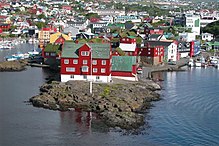
Tinganes, the peninsula in the capital Tórshavn. This is where national politics have been made for over 1000 years.

The Faroe Islands have had their own stamps since 1976, and this one was designed by the artist Zacharias Heinesen and shows the flag of the Faroe Islands.
_-_colored.svg.png)
The 29 Faroese municipalities since 1 January 2017
_-_colored.svg.png)
The six Faroese regions (sýslur)
Questions and Answers
Q: What are the Faroe Islands?
A: The Faroe Islands are a group of eighteen islands in the north Atlantic Ocean between Scotland, Norway, and Iceland.
Q: Who has local rule over the Faroe Islands?
A: The Faroe Islands have had local (autocratic) rule since 1948.
Q: When did people in the Faroe Islands gain the right to do business with people from all countries?
A: People in the Faroe Islands have had the right to do business with people from all countries since 1856.
Q: Who controls most government matters in the Faroes?
A: Most government matters are controlled by the Faroese government, except for military defense.
Q: How does the island group compare to other areas?
A: The Faroes have similarities to Iceland, Shetland, the Orkney Islands, the Outer Hebrides and Greenland.
Q: When did they leave Norway?
A: The island group left Norway in 1815.
Q: Do they have representatives in any councils or organizations?
A: Yes, they have their own representatives in the Nordic Council.
Search within the encyclopedia